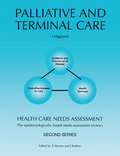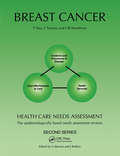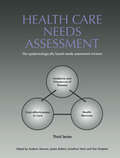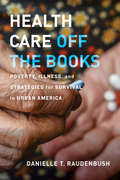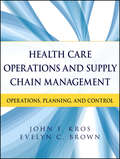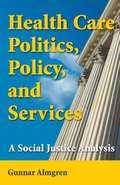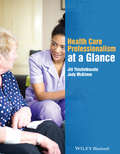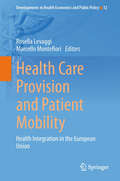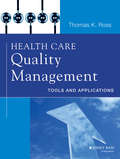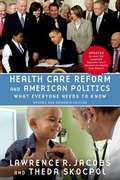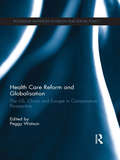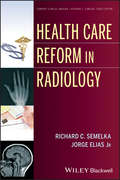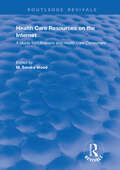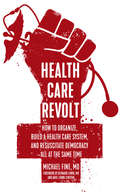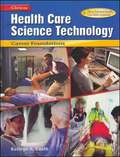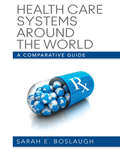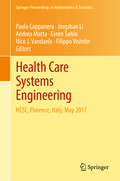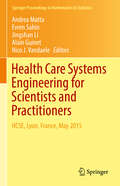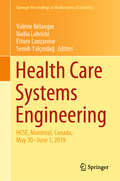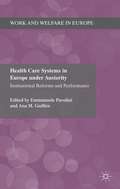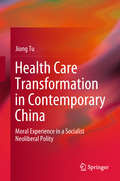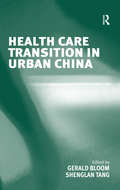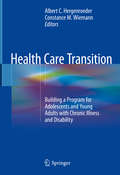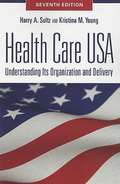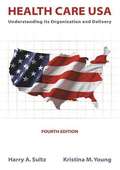- Table View
- List View
Health Care Needs Assessment: The Epidemiologically Based Needs Assessment Reviews
by Ian HigginsonThis volume, focusing on palliative and terminal care, is part of a survey of health care needs for specific conditions, published on behalf of the Department of Health. This study overall considers questions such as the population's needs, the services available or unavailable to them, the effectiveness of these services, and other perspectives in disease and service areas. This is the second series of needs assessment reviews.
Health Care Needs Assessment: The Epidemiologically Based Needs Assessment Reviews
by P. DeyThis volume, focusing on breast cancer, is part of a survey of health care needs for specific conditions, published on behalf of the Department of Health. This study overall considers questions such as the population's needs, the services available or unavailable to them, the effectiveness of these services, and other perspectives in disease and service areas. This is the second series of needs assessment reviews.
Health Care Needs Assessment: The Epidemiologically Based Needs Assessment Reviews, v. 2, First Series
by Jonathan Mant Andrew Stevens James Raftery Sue SimpsonThis new resource in the series provides vital perspectives across entire new disease and service areas not previously covered in other volumes. The books of the first and second series are well established as the key sources of data on needs assessment. Together, they describe the central role and aim of health care needs assessment in the National Health Service. The epidemiological approach to needs assessment is explained thoroughly, and is then applied to the effectiveness and availability of services. This definitive guide is ideal for all those involved in commissioning health care. It is invaluable for public health professionals, epidemiology and public health academics, and students of public health and epidemiology. Key reviews of the First Series: "An excellent balanced account...the definitive resource" - "Journal of the Association for Quality in Healthcare". "Excellent...it should be delved into deeply" - "Pharmaceutical Times". "This excellent work moves us closer to implementing a market in health care" - "British Medical Journal".
Health Care Off the Books: Poverty, Illness, and Strategies for Survival in Urban America
by Danielle T. RaudenbushMillions of low-income African Americans in the United States lack access to health care. How do they treat their health care problems? In Health Care Off the Books, Danielle T. Raudenbush provides an answer that challenges public perceptions and prior scholarly work. Informed by three and a half years of fieldwork in a public housing development, Raudenbush shows how residents who face obstacles to health care gain access to pharmaceutical drugs, medical equipment, physician reference manuals, and insurance cards by mobilizing social networks that include not only their neighbors but also local physicians. However, membership in these social networks is not universal, and some residents are forced to turn to a robust street market to obtain medicine. For others, health problems simply go untreated. Raudenbush reconceptualizes U.S. health care as a formal-informal hybrid system and explains why many residents who do have access to health services also turn to informal strategies to treat their health problems. While the practices described in the book may at times be beneficial to people’s health, they also have the potential to do serious harm. By understanding this hybrid system, we can evaluate its effects and gain new insight into the sources of social and racial disparities in health outcomes.
Health Care Operations and Supply Chain Management
by John F. Kros Evelyn BrownHealth Care Operations and Supply Chain ManagementThis innovative text offers a thorough foundation in operations management, supply chain management,?and the strategic implementation of programs, techniques, and tools for reducing costs and improving quality in health care organizations. The authors incorporate the features and functions of Microsoft Excel where appropriate in their coverage of supply chain strategy, process design and analysis of health care operations, managing health care operations quality, and planning and controlling health care operations.Health Care Operations and Supply Chain Management offers real-world examples to illustrate the most current concepts and techniques such as value stream mapping and Six Sigma. In addition, the authors clearly demonstrate how operations and process improvement relate to contemporary health care trends such as evidence-based medicine and pay-for-performance.Health Care Operations and Supply Chain Management contains:Leading edge concepts and techniquesReal-life data and actual examples from health care settings to underscore the main concepts in the textInstruction in the use of Microsoft Excel for health care operations and supply side managementThe book's numerous screen shots and detailed instructions guide the student through the use of Microsoft Excel's many functions and features.
Health Care Politics, Policy and Services: A Social Justice Analysis
by Gunnar AlmgrenThis is an outstanding book which examines the ecology, organization, and financing of health care policies and practices. The social justice perspective provides an original framework for incorporating the consequences of discrimination, oppression, economic injustice, empowerment, and reconciliation into health care policies and practices.
Health Care Professionalism at a Glance
by Judy Mckimm Jill ThistlethwaiteHealth Care Professionalism at a Glance offers accessible coverage of an increasingly important aspect of medical and health professional education. This concise text includes how to identify and develop professional behaviours, how they are assessed, and how to challenge unprofessional behaviours. Health Care Professionalism at a Glance: Provides a user-friendly and thought provoking overview of health care professionalism Introduces the main topics, key definitions and explores aspects relevant to learners and novice professionals Considers fundamental features of professionalism that students are expected to acquire as well as how they are taught, learned and assessed Includes summary boxes that highlight important points, reflection points, clinical cases and suggested further reading Includes references relevant to different countries accrediting bodies This important new book will assist students in understanding the nature of professionalism, its assessment, and the implications for professional practice.
Health Care Provision and Patient Mobility
by Rosella Levaggi Marcello MontefioriPatient mobility across Europe is markedly increasing and new generations will actively ask to be treated by the health-care system that best meets their needs. At a political level, the EU issued the EU Directive no. 24/2011/CE of 9th March 2011 concerning the application of patients' rights in cross-border health care and has contributed to improving the level of freedom of choice for the European citizen, but it does not seem to have increased actual patient mobility across Europe. Freedom to choose is necessary to grant the people of Europe the same access to public-sector health-care services. The latter is a key instrument for an efficiently functioning "single market" ensuring real mobility within the EU. The aim of this book is to study the current European health care market and discuss the hypothesis of a European right of citizenship with reference to health-care services. It examines patients' mobility from several perspectives: determinants of patient mobility, governance of cross-border mobility at EU level as concerns patients and health-care professionals, policy implications, and case studies. It is intended for health researchers, decision-makers and professionals concerned with health-care provision and patient mobility. The goal is to provide, through scientific and methodological rigor, new informative tools useful for the implementation of new policies in the health-care sector in order to implement effective health-care integration in the European Union.
Health Care Quality Management
by Thomas K. RossIn today's challenging health care environment, health care organizations are faced with improving patient outcomes, redesigning business processes, and executing quality and risk management initiatives. Health Care Quality Management offers an introduction to the field and practice of quality management and reveals the best practices and strategies health care organizations can adopt to improve patient outcomes and program quality.Filled with illustrative case studies that show how business processes can be restructured to achieve improvements in quality, risk reduction, and other key business results and outcomesClearly demonstrates how to effectively use process analysis tools to identify issues and causes, select corrective actions, and monitor implemented solutionsIncludes vital information on the use of statistical process control to monitor system performance (variables) and outcomes (attributes)Also contains multiple data sets that can be used to practice the skills and tools discussed and reviews examples of where and how the tools have been applied in health careProvides information on root cause analysis and failure mode effects analysis and offers, as discussion, the clinical tools and applications that are used to improve patient careBy emphasizing the tools of statistics and information technology, this book teaches future health care professionals how to identify opportunities for quality improvement and use the tools to make those improvements.
Health Care Reform and American Politics: What Everyone Needs to Know
by Lawrence R. Jacobs Theda SkocpolThe Patient Protection and Affordable Care Act signed by President Obama in March 2010 is a landmark in U. S. social legislation, and the Supreme Court's recent decision upholding the Act has ensured that it will remain the law of the land. The new law extends health insurance to nearly all Americans, fulfilling a century-long quest and bringing the United States to parity with other industrial nations. Affordable Care aims to control rapidly rising health care costs and promises to make the United States more equal, reversing four decades of rising disparities between the very rich and everyone else. Millions of people of modest means will gain new benefits and protections from insurance company abuses - and the tab will be paid by privileged corporations and the very rich. How did such a bold reform effort pass in a polity wracked by partisan divisions and intense lobbying by special interests? What does Affordable Care mean-and what comes next? In this updated edition of Health Care Reform and American Politics: What Everyone Needs to Know®, Lawrence R. Jacobs and Theda Skocpol-two of the nation's leading experts on politics and health care policy-provide a concise and accessible overview. They explain the political battles of 2009 and 2010, highlighting White House strategies, the deals Democrats cut with interest groups, and the impact of agitation by Tea Partiers and progressives. Jacobs and Skocpol spell out what the new law can do for everyday Americans, what it will cost, and who will pay. In a new section, they also analyze the impact the Supreme Court ruling that upheld the law. Above all, they explain what comes next, as critical yet often behind-the-scenes battles rage over implementing reform nationally and in the fifty states. Affordable Care still faces challenges at the state level despite the Court ruling. But, like Social Security and Medicare, it could also gain strength and popularity as the majority of Americans learn what it can do for them. What Everyone Needs to Know® is a registered trademark of Oxford University Press.
Health Care Reform and Globalisation: The US, China and Europe in Comparative Perspective
by Watson PeggyIn the post-Cold War, post financial crisis era, health care is an issue of critical political, personal and economic concern. In the US, plans to address a troubled health care model were met by vocal opposition. In the UK and post-communist Europe, attempts to introduce aspects of that model have resulted in controversy and violent protests, while China and Russia have recently backpedalled on marketising reforms. This innovative book provides a timely analysis addressing the many dimensions of radical health care change. Bringing together three major geopolitical regions with strikingly different recent histories, this international cast of contributors, examines reform in US, China and Europe within a single study frame. They look at the processes that have been involved when countries with such diverse starting points try to move towards a globally shared health care framework. An underlying theme running through the chapters is access to care, and how it is shaped by moral economies, by what can be said and known, and by political and economic power. Health Care Reform and Globalisation confronts the interpretations and experiences of patients, professionals, and politicians of health care transformation in practice. It will be of interest to scholars from a range of diverse disciplinary backgrounds, including public health, anthropology, area studies, sociology, politics, social policy, geography and economics.
Health Care Reform in Radiology
by Richard C. Semelka Jorge EliasThe first book-length treatment of the absolutely essential topic of U.S. health care reform for imaging specialistsThis latest volume in the Current Clinical Imaging series offers all professionals involved with imaging a cogent, concise discussion of major issues related to health care reform from the perspective of fellow imaging specialists. It provides radiologists with a solid footing in understanding where they are now and where they can expect to be in the evolution of health care reform over the next ten years.Presenting an excellent balance of clinical and health care policy issues, Health Care Reform in Radiology reinforces the central role of health promotion and preventive medicine in U.S. health care systems while offering an international perspective on the subject. Topical coverage includes evidence-based outcomes for health care delivery, the impact of the determination of imaging tests' effectiveness, patient safety, medicolegal reform, reimbursement issues, and universal healthcare benefits and challenges.Health Care Reform in Radiology presents a program to:Enhance patient safety and quality of careAnticipate new or revised standards for all imaging modalitiesSuggest the more appropriate use of imaging based on the latest clinical evidenceDiscuss the evolving regulations defining the training required to perform imaging proceduresEncourage career-long learning (CME, maintenance of certification, etc.)Show fellow radiologists how to provide added value for patients and referring physiciansDeveloped and written by two top experts in the field, this is an ideal book for all professionals involved with imaging as well as physician groups that depend on radiology.
Health Care Resources on the Internet: A Guide for Librarians and Health Care Consumers
by Mls M. Sandra WoodMake Internet medical research simpler and more productive!The rapid proliferation of Web sites makes finding medical information easy. Knowing when the information is accurate and reliable can be much more difficult. Health Care Resources on the Internet: A Guide for Librarians and Health Care Consumers discusses how to locate, evaluate, and use health care information available in online form. As expectations shift from finding information in books to locating it on the World Wide Web, Health Care Resources on the Internet provides you with the skills you need. Whether you?re a first-time Internet user unfamiliar with search engines or an old hand at Boolean logic, you will find helpful search tips and strategies. Moreover, this comprehensive book offers specific advice on assessing the reliability of the information you find.Health Care Resources on the Internet simplifies your hunt for information by recommending trustworthy Web sites. It covers topics including:consumer and professional megasites for health care informationusing Medlinesearching for information on specific diseasesfinding open clinical trialsconsumer health informationalternative medicineIllustrated with tables and figures, Health Care Resources on the Internet is an essential guidebook for health-conscious consumers, information professionals, and medical professionals.
Health Care Revolt: How to Organize, Build a Health Care System, and Resuscitate Democracy—All at the Same Time
by Bernard Lown Michael Fine Ariel Lown LewitonToday's deliberations about a revamped health care system are stuck. We need a fresh analysis and a new vision. Health Care Revolt sets out to provide just that and at a most propitious time in U.S. history. Dr. Michael Fine's manifesto frames the questions more expansively than others before him and offers an impassioned road map for a nation confused about which health care direction to travel. The crux of Dr. Fine's argument is that the U.S. does not have a health system. Rather we have put our faith in a so-called marketplace in which the few profit from the public's ill-health. This ailing market has accelerated the erosion of American democracy by contributing to economic polarization. Health Care Revolt looks around the world for examples of health care systems that are effective and affordable, pictures such a system for the U.S., and creates a practical playbook for a political revolution in health care that will allow the nation to protect health while strengthening democracy. Dr. Fine's voice is likely to command attention. He writes with the experience of a clinician, State public health commissioner, scholar, and community organizer. He illustrates his points with personal stories and acute analysis, conveying medicalese in ways that readers will find comprehensible.
Health Care Science Technology: Career Foundations
by Kathryn A. BoothDevelops the skills your students will need for a career in health care! Glencoe's Health Care Science Technology: Career Foundations is written to address the National Health Care Skills Standards. It covers general skills such as teamwork and communication, as well as skills required for specific jobs with the career pathways. This text helps your students build a solid foundation for success, no matter which health care career they choose!
Health Care Systems Around the World: A Comparative Guide
by Sarah E. BoslaughThis concise reference provides a one-stop point of research that examines major aspects of health care systems for over 190 countries worldwide. In a consistent format, ten major health care categories are systematically examined for each country: 1. Emergency Health Services; 2. Costs of Hospitalization; 3. Costs of Drugs; 4. Major Health Issues; 5. Government Role in Health Care; 6. Insurance; 7. Access to Health Care; 8. Health Care Facilities; 9. Health Care Personnel (doctor level of training, etc.); and 10. Public Health Programs. The volume is organized in alphabetical order of country names. Each country is presented on a two- or three-page spread with the same descriptive and statistical content, allowing readers to compare health care systems from country to country. For example, a reader may compare costs of drugs in France versus the United States versus Canada. Each country spread will feature short entries on the ten health care categories accompanied by charts, table, and photos as appropriate. The work culminates as a unique and essential resource for pre-med and medical students, as well as researchers in sociology, economics, and the health management fields.
Health Care Systems Engineering
by Jingshan Li Andrea Matta Evren Sahin Nico J. Vandaele Paola Cappanera Filippo VisintinThis book presents statistical processes for health care delivery and covers new ideas, methods and technologies used to improve health care organizations. It gathers the proceedings of the Third International Conference on Health Care Systems Engineering (HCSE 2017), which took place in Florence, Italy from May 29 to 31, 2017. The Conference provided a timely opportunity to address operations research and operations management issues in health care delivery systems. Scientists and practitioners discussed new ideas, methods and technologies for improving the operations of health care systems, developed in close collaborations with clinicians. The topics cover a broad spectrum of concrete problems that pose challenges for researchers and practitioners alike: hospital drug logistics, operating theatre management, home care services, modeling, simulation, process mining and data mining in patient care and health care organizations.
Health Care Systems Engineering for Scientists and Practitioners
by Jingshan Li Andrea Matta Evren Sahin Alain Guinet Nico J. VandaeleIn this volume, scientists and practitioners write about new methods and technologies for improving the operation of health care organizations. Statistical analyses play an important role in these methods with the implications of simulation and modeling applied to the future of health care. Papers are based on work presented at the Second International Conference on Health Care Systems Engineering (HCSE2015) in Lyon, France. The conference was a rare opportunity for scientists and practitioners to share work directly with each other. Each resulting paper received a double blind review. Paper topics include: hospital drug logistics, emergency care, simulation in patient care, and models for home care services. Discusses statistical analysis and operations management for health care delivery systems based on real case studies Papers in this volume received a double blind review Brings together the work of scientists, practitioners, and clinicians to unite research and practice in the future of these systems Topics include: hospital drug logistics, emergency care, modeling and simulation in patient care and healthcare organizations and in home care services
Health Care Systems Engineering: HCSE, Montréal, Canada, May 30 - June 1, 2019 (Springer Proceedings in Mathematics & Statistics #316)
by Ettore Lanzarone Valérie Bélanger Nadia Lahrichi Semih YalçındağThis book presents the proceedings of the Fourth International Conference on Health Care Systems Engineering (HCSE 2019), which took place in Montreal, Canada, from May 30 to June 1, 2019. The event took place in the mother and child university hospital CHU Sainte-Justine in Montréal, and each session was co-chaired by a discussant coming from the clinical practice.The conference offered scientists and practitioners an opportunity to discuss operations management issues in health care delivery systems, and to share new ideas, methods and technologies for improving the operation of health care organizations.Focusing on applications of systems engineering, optimization and statistics to improve health care delivery and health systems, the book covers topics relating to a broad spectrum of concrete problems that pose challenges for researchers and practitioners alike, including hospital drug logistics, operating theatre management, blood donation, home care services, modeling, simulation, process mining and data mining in patient care and health care organizations.
Health Care Systems in Europe under Austerity
by Emmanuele Pavolini Ana M. GuillénThis book analyses recent reform trends of European health care systems. Using eight European countries case studies it connects policy reforms with a healthcare quadrilemma, and compares how well these systems perform in terms of economic efficiency, medical achievements, social inequalities, and responsiveness to patients and workers.
Health Care Transformation in Contemporary China: Moral Experience in a Socialist Neoliberal Polity
by Jiong TuThis multifaceted book examines the free market reform of the Chinese healthcare system in the 1980s and the more collectivist or socialist counter-reforms that have been implemented since 2009 to remedy some of the problems introduced by marketization. The book is based on an ethnographical study in a Chinese county from 2011 to 2012, which investigated local people’s experience of healthcare reforms and the various ways in which they have adapted their own behavior to the constraints and opportunities introduced by these reforms. It provides a vivid depiction of the morality and emotionality of people’s experiences of the Chinese healthcare system and the myriad frustrations and sometimes desperation it induces not only among patients with significant health problems and their families, but also healthcare practitioners caught between their desire to do right by their patients and the penalties they personally incur if they do not adhere to institutionalized cost-saving measures. The people’s experiences within China’s health sector presented reflect many similar experiences in the wider Chinese society. The book is thus a valuable resource for researchers and graduate students interested in China’s healthcare reforms and scholars concerned with issues of contemporary Chinese society.
Health Care Transition in Urban China
by Shenglan TangThe on-going transition to a market economy in China is having a profound effect on health services. As a result, the government has made health one of the key policy areas, and there is now a general recognition of the need to reform urban health services. Multidisciplinary in scope, this exceptional volume draws on a prestigious report to explore how changes in health finance have affected the performance of urban health services in terms of equity and efficiency. Based on empirical evidence from the cities of Nantong, Jiangsu Province and Zibo, Shandong Province (selected for their innovative approach to health system development), the book offers an in-depth understanding of the relationship between transition, health reform and health system performance in urban settings. It features collaboration between European and Chinese academics and Chinese practitioners and officials, providing valuable background and contextual information on a complex system of healthcare, and presenting an analysis of policy impact and likely future direction.
Health Care Transition: Building A Program For Adolescents And Young Adults With Chronic Illness And Disability
by Albert C. Hergenroeder Constance M. WiemannThis comprehensive book thoroughly addresses all aspects of health care transition of adolescents and young adults with chronic illness or disability; and includes the framework, tools and case-based examples needed to develop and evaluate a Health Care Transition (HCT) planning program that can be implemented regardless of a patient’s disease or disability. Health Care Transition: Building a Program for Adolescents and Young Adults with Chronic Illness and Disability is a uniquely inclusive resource, incorporating youth/young adult, caregiver, and pediatric and adult provider voices and perspectives. Part I of the book opens by defining Health Care Transition, describing the urgent need for comprehensive transition planning, barriers to HCT and then offering a framework for developing and evaluating health care transition programs. Part II focuses on the anatomic and neuro-chemical changes that occur in the brain during adolescence and young adulthood, and how they affect function and behavior. Part III covers the perspectives of important participants in the HCT transition process – youth and young adults, caregivers, and both pediatric and adult providers. Each chapter in Part IV addresses a unique aspect of developing HCT programs. Part V explores various examples of successful transition from the perspective of five key participants in the transition process - patients, caregivers, pediatric providers, adult providers and third party payers. Related financial matters are covered in part VI, while Part VII explores special issues such as HCT and the medical home, international perspectives, and potential legal issues. Models of HCT programs are presented in Part VIII, utilizing an example case study. Representing perspectives from over 75 authors and more than 100 medical centers in North America and Europe, Health Care Transition: Building a Program for Adolescents and Young Adults with Chronic Illness and Disability is an ideal resource for any clinician, policy maker, caregiver, or hospitalist working with youth in transition.
Health Care USA
by Harry A. Sultz Kristina M. YoungHealth Care USA, Seventh Edition, Offers Students Of Health Administration, Medicine, Public Health, And Related Fields The Most Comprehensive Overview Of America's Health Care System Under A Single Cover. Combining Historical Perspective With Analysis Of Modern Trends, This Expanded Edition Charts The Evolution Of Modern American Health Care, Providing A Complete Examination Of Its Organization And Delivery While Offering Critical Insight Into The Issues That The U. S. Health System Faces Today. From A Physician-Dominated System To One Defined By Managed Care And Increasingly Sophisticated Technology, This Essential Text Explains The Transformation Underway And The Professional, Political, Social, And Economic Forces That Guide It Today And Will In The Future. Exhaustive In Breadth And Balanced In Perspective, Health Care USA, Seventh Edition, Provides Students With A Clearly Organized, Straightforward Illustration Of The Complex Structures, Relationships And Processes Of This Rapidly Growing, $2. 5 Trillion Industry. The Seventh Edition Has Been Thoroughly Revised To Reflect Recent Developments In This Dynamic Industry. The Latest Edition Features: - A Comprehensive Overview Of The Complex And Evolving U. S. Health Care System, Plus Revised Data, Material And Analysis Throughout. - The Latest Benchmark Developments In Health Care, Including The Response Of Public Health To Swine Flu And The Obama Administration's Health Care Reform. - A Look At The Recent Recession's Effects On Hospital Finances. - New Projections And Data Trends On The Country's Health Care Spending. - A Forward-Looking Perspective On The Future Of The U. S. Health Care System.
Health Care USA: Understanding its Organization and Delivery (Fourth Edition)
by Harry A. Sultz Kristina M. YoungA Clear overview of the health care industry and the issues that confront it.A college textbook.
